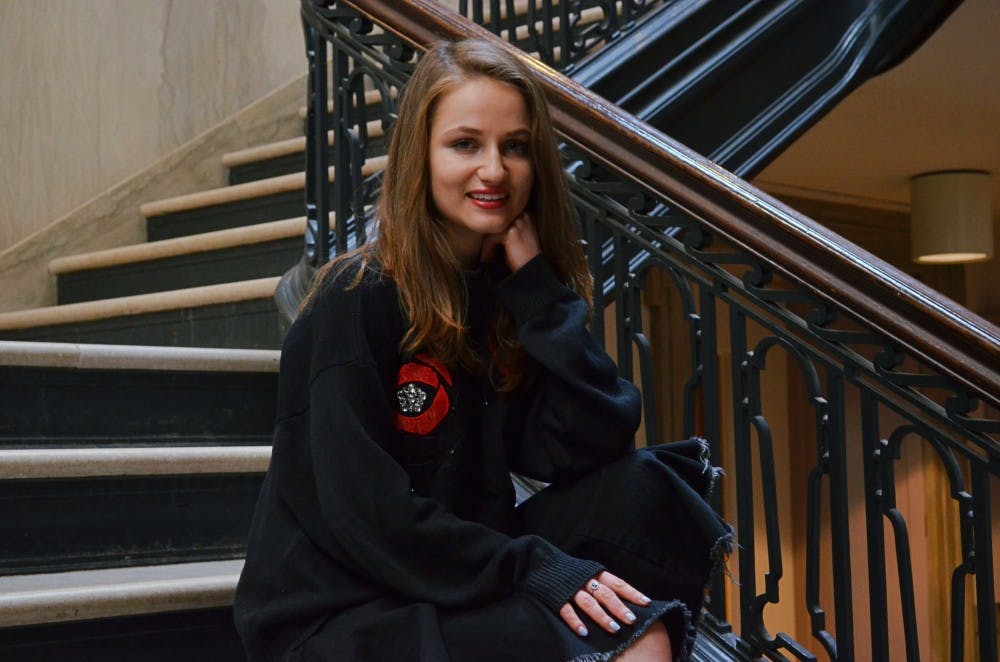When Emily Cieslak (C '19) first walks into Fisher–Bennett Hall, her outfit demands everyone’s attention. She’s wearing black pants with frayed edges that are ruffled like a skirt, a daring length above her bright red heels. Her top is a thick sweater that is all black except for two sequined roses, the motif of red completed by her lipstick.
As editor–in–chief of The WALK, Penn’s premier fashion magazine, Emily has a lot of experience staging photoshoots, writing about style, and being on the lookout for new, ever–changing trends. But her appetite for fashion began far before Penn. The first time Emily discovered fashion was in the magazine aisle of a grocery store.
She was a kid in Wenatchee, Washington, bored out of her mind while her mother was shopping. She recalls flipping through random issues with interesting covers and stumbling upon her future passion as she strolled by the magazine stands. In Wenatchee, where clothing was casual and all about convenience, Emily was amazed to see people wearing styles and bright colors she’d never imagined.
“I would read every fashion magazine I could get my hands on and keep all of them,” she says. “I still look back at them.”
In high school, she never got the chance to do anything with fashion, so it was critical to her that her future college had lots of opportunity. She wanted to live in a big city with an emphasis on style on the East Coast, and Penn was one of few schools that already had a fashion magazine, The WALK.
“I always knew I really loved fashion and writing,” she says, “And this was kind of like the dream of a fashion magazine.”
It wasn’t long before Emily threw herself into the print magazine and website, becoming editor–in–chief by the fall of her senior year. Now she’s in charge of a whole team of fashion–focused writers and photographers, all of whom work to produce a print issue every semester revolving around a single theme.

The UNTAMED Issue, which was released at the beginning of the semester, features a drag queen in a flashy gold and nude–colored dress with deep purple blush and lipstick on the front cover. Emily says their cover story on the Philly drag scene opened her eyes to the diversity of fashion.
“That was really monumental for us because we’d never really covered LGBTQ issues in the magazine,” she says. “One of my goals this year had really been to make our magazine and the stuff we write about more diverse.”
Showing students that there’s more to fashion than the most popular trend is Emily’s hope for The WALK.
“As a fashion magazine, we want to say, ‘No you don’t all have to dress the same,’” she says. “That’s the beauty of fashion. You can experiment and have a different kind of style every day if you want. And especially at this age, when we’re young and at the pulse of everything, we shouldn’t feel like, ‘Oh, I can only wear black,’ or ‘I shouldn’t try something new.’ Now’s the time to try out crazy trends.”
Working for The WALK has taught Emily and her staff discipline. It has given them many opportunities to branch out into the working world. Emily praises her team for building a magazine from scratch only on their “own passion and interest.” This independence has allowed them to improvise and gain experience as stylists and journalists, which has helped Emily herself gain internships working in the fashion industry.

In 2017, she even got to fly to L.A. to work for Brooklyn PR, a clothing showroom that celebrity stylists use to rent outfits for their clients. Emily recalls steaming a pantsuit rented by Julia Roberts and helping Zendaya’s stylist pick outfits for the actress’s Spider–Man: Homecoming press tour.
Emily will be graduating with a BA in English in May, and she’s eager to pursue a career in fashion, especially as a writer. She says that fashion and writing are creative passions that complement each other well.
“What I like about fashion is that you can be someone different every day based on how you style yourself,” she says. “I like having different clothing items and finding different ways to put them together.”
In the same way, writing allows her to take different parts of a story, such as interviews, quotes, and her own impressions, and piece them together like a “puzzle.”
Emily believes that combining the two allows people to have critical discussions on culture and identity, similar to the discussions she had with her staff when they covered the Philly drag scene.
“Fashion and the retail industry are not just about clothes,” she says. “It’s issues about politics and gender and economics. Writing about fashion allows us to explore those issues.”







